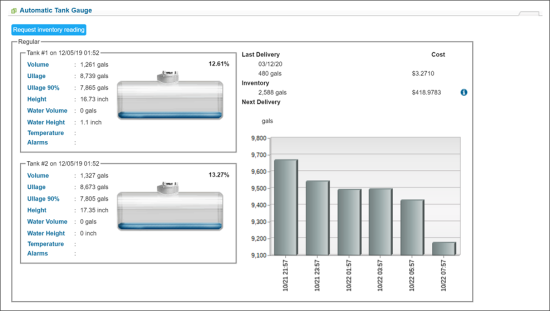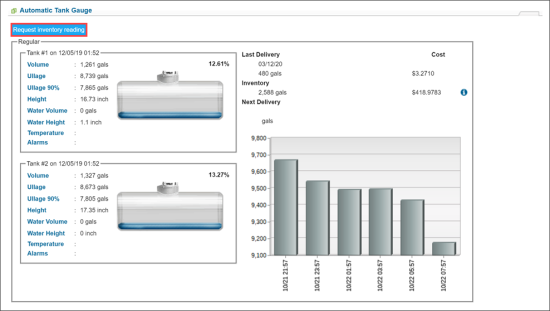The Fuel Inventory form allows the viewing of any inventory from ATG or CR reporting. Fuel inventory readings can also be entered manually from the Veeder Root daily print out.
The following fuel inventory options are available:
- Enter stick reading inches as a decimal/eighth fraction: Select this option to specify whether you want to enter the stick reading inches in 1/8 or 0.125 format.
- Disable tank charts: Select this option to disable the inches to gallons recalculation.
In the Fuel Inventory form, you can perform the following operations:
- Enter or update the fuel inventory reading.
- Delete the fuel inventory reading.
- View and request fuel inventory readings.
- View the related information.
Entering or Updating the Fuel Inventory Reading Manually
If you don't want to continue with entering or updating the fuel inventory data and don't want to save your changes, you can click the Revert button at any step.
To enter or update the fuel inventory reading manually:
- From the CStoreOffice® home page, go to Data Entry > Fuel Inventory.
Result: The Fuel Inventory form opens. - Set up the initial data for entering the fuel inventory:
- At the top right of the page, select the station.
- At the top of the Fuel Inventory form, select the date.
- At the top right of the Fuel Inventory form, click Add or Edit correspondingly.
- Enter either the gallon amount or the stick reading amount in inches for each tank.
- Enter the stick reading water level (if any) for each tank.
- Once the water level and Stage II equipment checks are completed, select the corresponding check boxes:
- Did you check water level?
- Did you check STAGE II equipment?
- Click Save.
The form will show short/over for the day and the month in each tank.
Deleting the Fuel Inventory Data
To delete the fuel inventory reading:
- From the CStoreOffice® home page, go to Data Entry > Fuel Inventory.
Result: The Fuel Inventory form opens. - Set up the initial data for deleting the fuel inventory:
- At the top right of the page, select the station.
- At the top of the Fuel Inventory form, select the date.
- At the top right of the Fuel Inventory form, click Delete.
- Confirm the deletion.
Result: The fuel inventory data is deleted. The Fuel Inventory form opens for the first previous date with the fuel inventory data.
Viewing and Requesting Fuel Inventory Readings
CStoreOffice® communicates with ATG (Automatic Tank Gauging) systems to get the information about the state of fuel equipment set up at the station. ATG systems use sensors installed in tanks, pumps and other gas equipment to collect information about the equipment state, level of fuel and so on. One of the most popular ATG systems is Veeder Root by Gilbarco.
The collected metrics and data are presented in CStoreOffice® in the Fuel Inventory > Automatic Tank Gauge section. The data is broken down by fuel product and tank.
The Automatic Tank Gauge section displays metrics and graphs on the following tank readings collected from ATG sensors:
- ATG date and time: Should be equal to the date and time of the last station closure which you can check in the Custom Shifts Reaccept report.
- Volume: The actual volume of fuel in the tank (in gallons).
- Ullage: The space between the fuel level and the top of the tank, that is, the amount by which the tank falls short of being full (in gallons).
- Ullage 90%: The space between the fuel level and the top of the tank, that is, the amount by which the tank falls short of being full (in gallons) multiplied by 0.90.
The Ullage 90% value is calculated using the following formula:
90% Ullage = Ullage - 10% * (Ullage + Volume)CStoreOffice® calculates the ullage 90% value as the ratio for ullage not taking into account the equipment temperature at the gas station. Veeder Root, however, considers temperature conditions for more accurate ullage calculation. For this reason, the ullage values calculated in CStoreOffice® and Veeder Root may differ.
- Height: The level of fuel in the tank (in inches).
- Water Volume: The volume of water in the tank (in gallons).
- Water Height: The level of water in the tank (in inches).
- Temperature: The temperature in the tank.
- Alarms: Alarms received from the ATG system.
- Last Delivery/Cost: The date, volume and cost of the last delivery.
- Inventory: The actual volume of fuel of the last inventory (in gallons).
- Next Delivery: The date, shift and expected volume of fuel (in gallons) to be delivered with the next delivery.
CStoreOffice® periodically updates data in the Automatic Tank Gauge section. To get the latest fuel equipment readings from ATG sensors manually, at the top of the Automatic Tank Gauge section, click Request inventory reading. CStoreOffice® will request data from ATG sensors installed at each station of the account, and the Fuel Inventory form will be reloaded to display the updated data.
For more information on how to work with ATG in CStoreOffice®, go to Configuring ATG Settings.
Viewing the Related Information
In the Related Information section, helpful links pertaining to fuel inventory can be viewed.
- Reports. Links to the Fuel reports section.
- Fuel Inventory Report: Links to the fuel inventory report for SIR.
- Order Gasoline: Shows fuel sales projections and a fuel orders forecast. For details, see Order Gasoline Report.
- Regular SIR: This shows inventory levels of regular fuel compared to the government standard. It helps the user see if their inventory is passing EPA standards.
- Ultra SIR: This shows inventory levels of ultra fuel compared to the government standard. It helps the user see if their inventory is passing EPA standards.
- Stick Reading Manuals: Opens the help page with the helpful manuals containing useful recommendations about using additional equipment, measuring the tank contents, and inventory control. For details, see Stick Reading Manuals.
- Send inventory report to email: This opens the Alerts > Fuel Inventory section where alerts can be set up for receiving alerts with fuel inventory data.




